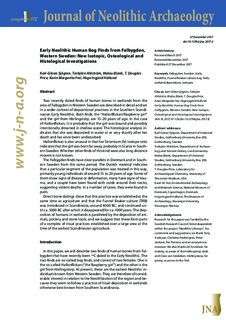| dc.contributor.author | Sjögren, Karl-Göran | |
| dc.contributor.author | Ahlström, Torbjörn | |
| dc.contributor.author | Blank, Malou | |
| dc.contributor.author | Price, T. Douglas | |
| dc.contributor.author | Frei, Karin Margarita | |
| dc.contributor.author | Hollund, Hege Ingjerd | |
| dc.coverage.spatial | Sweden | nb_NO |
| dc.date.accessioned | 2019-01-22T08:47:27Z | |
| dc.date.available | 2019-01-22T08:47:27Z | |
| dc.date.created | 2018-04-06T21:57:31Z | |
| dc.date.issued | 2017-12 | |
| dc.identifier.citation | Sjögren, K.G. et al. (2018) Early Neolithic human bog finds from Falbygden, western Sweden. New isotopic, osteological and histological investigations. Journal of Neolithic Archaeology. 19, pp 97-126. | nb_NO |
| dc.identifier.issn | 2197-649X | |
| dc.identifier.uri | http://hdl.handle.net/11250/2581685 | |
| dc.description.abstract | Departing from two recently dated finds of human bones in wetlands from the area of Falbygden in western Sweden, this paper describes the finds in detail and sets them in a wider context of depositional practices in the south Scandinavian Early Neolithic. The two finds are both of girls in the age of 15-20 years, and in one of the cases it is probable that she was bound and possibly intentionally drowned in shallow water.
The Falbygden finds have clear parallels in Denmark and in southern Sweden in the same period. The Danish material indicates that a particular segment of the population was treated in this way, primarily young individuals around 15-20 years. Some of them show signs of disease or deformations, many have signs of trauma, and a couple have been found with cords around the neck, suggesting violent deaths. In a number of cases, they were also found in pairs.
One of the Falbygden finds, the so-called Hallonflickan, was also unusual in that her Sr isotope ratio indicates that the was born far away, probably in Scania in southern Sweden. Whether other finds of this kind were also long distance movers is not known.
Direct bone datings show that this practice is established at the same time as the introduction of agriculture and of the Funnel Beaker culture in Scandinavia, around 4000 BC, and continues until ca 3000 BC after which it disappears for ca 1000 years. Deposition of humans in wetlands is paralleled by deposition of animals, pottery and stone tools, and we suggest that these form parts of a complex of ritual practices established over a large area at the time of the earliest Scandinavian agriculture. | nb_NO |
| dc.language.iso | eng | nb_NO |
| dc.publisher | Institute of Prehistoric and Protohistoric Archaeology at Kiel University | nb_NO |
| dc.rights | Navngivelse 4.0 Internasjonal | * |
| dc.rights.uri | http://creativecommons.org/licenses/by/4.0/deed.no | * |
| dc.subject | arkeologi | nb_NO |
| dc.subject | osteologi | nb_NO |
| dc.subject | osteoarkeologi | nb_NO |
| dc.subject | Hallonflickan | nb_NO |
| dc.subject | Bringebærjenta | nb_NO |
| dc.title | Early Neolithic human bog finds from Falbygden, western Sweden. New isotopic, osteological and histological investigations | nb_NO |
| dc.type | Journal article | nb_NO |
| dc.type | Peer reviewed | nb_NO |
| dc.description.version | publishedVersion | nb_NO |
| dc.subject.nsi | VDP::Humaniora: 000::Arkeologi: 090::Nordisk arkeologi: 091 | nb_NO |
| dc.source.pagenumber | 97-126 | nb_NO |
| dc.source.journal | Journal of Neolithic Archaeology | nb_NO |
| dc.source.issue | 19 | nb_NO |
| dc.identifier.doi | 10.12766/jna.2017.4 | |
| dc.identifier.cristin | 1578045 | |
| dc.relation.project | Universitetet i Stavanger: IN-11355 | nb_NO |
| cristin.unitcode | 217,9,3,0 | |
| cristin.unitname | Avdeling konservering | |
| cristin.ispublished | true | |
| cristin.fulltext | original | |
| cristin.qualitycode | 1 | |

